Star Wars illustrator Matt Ferguson and the return of classic poster art
- Published
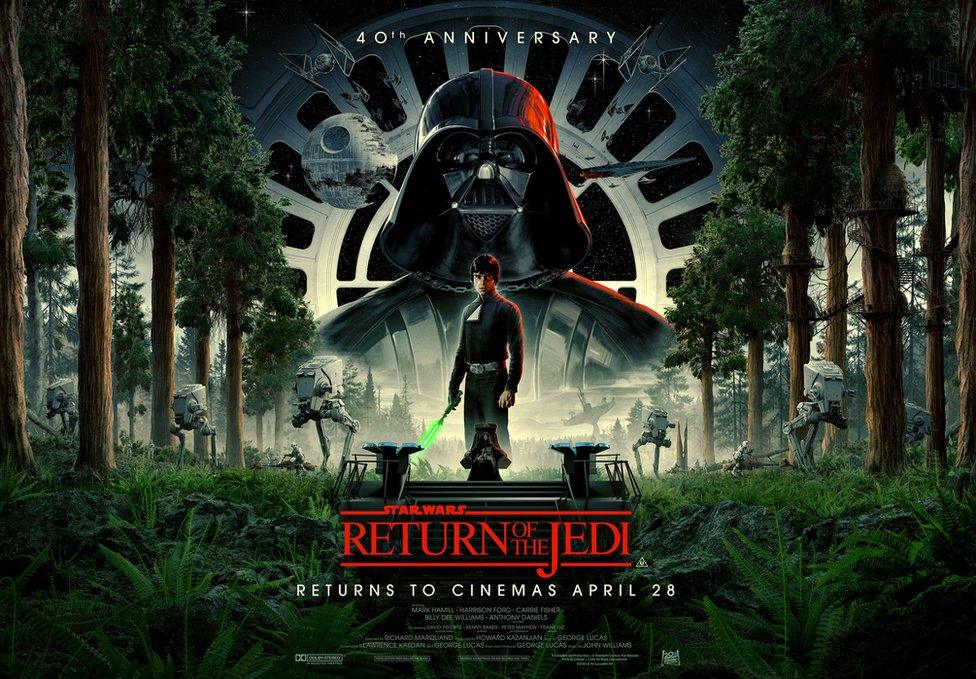
Matt Ferguson's Return of the Jedi poster was unveiled ahead of the film's 40th anniversary
"There must've been a couple of thousand fans there. It was like watching a band with lasers and music, and there were people in the audience with lightsabres going crazy," Matt Ferguson recalls with a wide-eyed grin.
As attendees at this month's Star Wars Celebration convention in London cheered news of a cinema release marking Return of the Jedi's 40th anniversary, Ferguson had more reason than most to be smiling.
Beaming out from across the stage was his artwork promoting the film.
"I can't think of a more exciting time in my career than that weekend because I was there and part of it and they said my name - 'poster by Matt Ferguson'.
"There's lots of pressure because of expectations from fans and my own standards, but also it's really fun because I've loved Star Wars my entire life.
"I'm a fan first. That's how I got started - doing artwork based on the things I like. It's almost unreal."
The 39-year-old from Sheffield was no stranger to depicting Luke Skywalker's battle against Darth Vader having been commissioned to create a poster for The Empire Strikes Back's 40th anniversary in 2020.
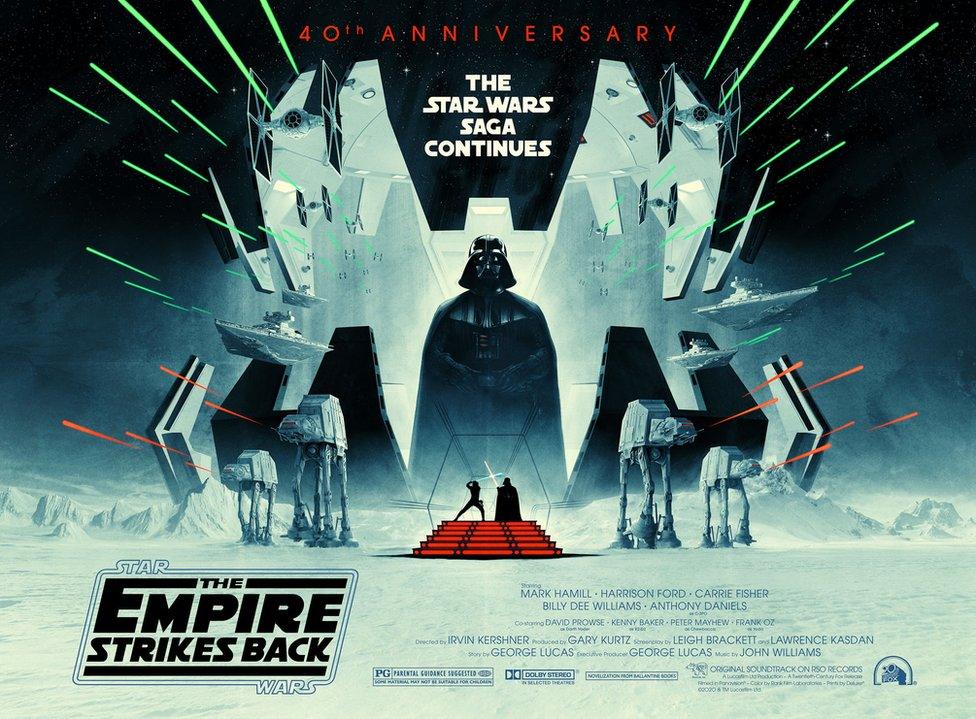
Ferguson's artwork for The Empire Strikes Back was a hit with fans of the Star Wars franchise
With the series' original artwork so familiar to generations of film-goers, that first project proved tough.
Adopting his preferred "storytelling" approach, key themes and emblems were picked out with the imposing Vader centre-stage, flanked by TIE fighters, AT-ATs and Star Destroyers.
"Because it was The Empire Strikes Back, which is the Star Wars movie, I had to come up with something I felt hadn't been done before - and there's been a lot of Star Wars art.
"[But] the designs of Star Wars are so good they lend themselves to it. They're other-worldly.
"It was very much about Darth Vader and then all the iconography of the Empire because they're chasing down the Rebels.
"With Return of the Jedi, it's Luke's story so I have him at the centre of proceedings with Vader looming large."
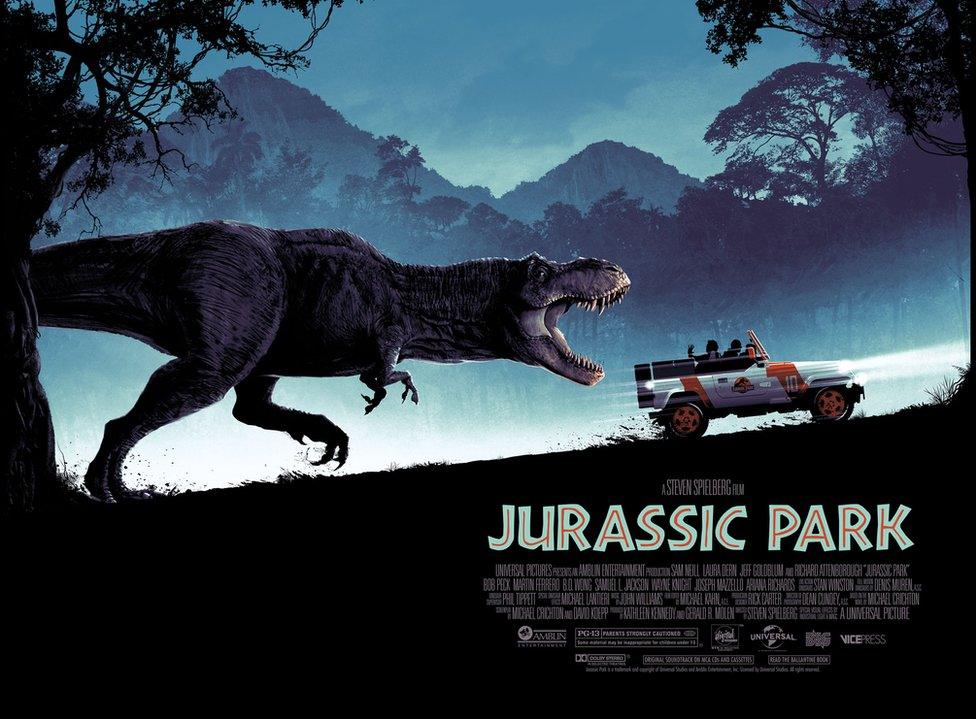
The illustrator used Jeff Goldblum's "must go faster!" line from the film as inspiration for his 2018 Jurassic Park poster
It is not just the Star Wars franchise which has called upon his talents, though. As well as being a long-time contributor to the Marvel universe, Batman, Blade Runner and Jurassic Park are among Ferguson's other projects.
So just how did he make the giant leap from working in a comics shop and selling DVDs at his local HMV store to a full-time role creating art for the biggest names in film?
Having "failed miserably at art school", one day he got an email "out of the blue" from an assistant for Hulk actor Mark Ruffalo.
They wanted a copy of a Hulk illustration Ferguson had posted on social media for the Hollywood star.
In 2012, Marvel enlisted him to design artwork for the DVD and Blu-ray box-set releases of its Phase One superhero stories. Within two years he had quit his job at HMV.
"It's been constant ever since," Ferguson says from his self-described Hobbit hole - a basement office where posters line the walls and Star Trek and Transformers action figures fill the shelves.

Ferguson was responsible for the official poster for the 2021 version of Dune by director Denis Villeneuve
Inspired by the "deceptively simple, stark" shots of director John Carpenter and the likes of ET poster designer John Alvin, he is part of a wave of artists who have helped revive a more creative style of work common in the 1970s and 80s.
Where hand-painted efforts by the likes of Alvin and his contemporaries Drew Struzan (Back to the Future), Bob Peak (Apocalypse Now) and Richard Amsel (Raiders of the Lost Ark) were once the norm, the 1990s saw a shift towards more formulaic composition with airbrushed photographs of movies' stars becoming dominant.
Key to kick-starting the renaissance would be small, independent operations in the United States with a "punk, DIY attitude".
Among those at the forefront was Mondo, a spin-off from the then single-screen Alamo Drafthouse in Austin, Texas, a cinema favoured by Hollywood trend-setters such as Quentin Tarantino and influential film bloggers.
Initially selling T-shirts, it began commissioning illustrators to reimagine posters of classic films being shown at the "dark, dirty second-floor theatre" where beer and pizza were served alongside the celluloid.

Apocalypse Now's poster, designed by Bob Peak, was among the most distinctive of the 1970s and 80s
Tim Doyle, Mondo's art director from 2004 to 2009, remembers selling posters in the cinema's lobby as well as pitching in as the "cook, waiter and ticket taker".
He said: "Back then, none of the work was licensed. It was just to promote events at the theatre and kind of in that grey area between bootleg and official merchandise.
"Usually we would find an artist we thought would work well with a property or be counter-intuitive so you got something crazy. It gave us a punk-rock ethos - like we know better than the movie studios.
"With the appreciation of older films [being shown there] came a love for the older poster styles, and it became clear the artwork we were producing had a much bigger life online as more and more people picked up on it."
Small print runs of between 50 and a few hundred posters were eagerly snapped up by fans and collectors.
Keen to capitalise on what the 46-year-old describes as the "underground promotional effect", film companies soon struck deals with Mondo and the likes of New York's Bottleneck Gallery and California's Gallery 1988 to partner on projects.
Doyle, who has run his own poster and printing company, Nakatomi Inc, since departing, adds: "It's always good to see illustrators getting high-profile work even if some of the more surprising aspects of the early days have dried up. It comes from this culture we built up."
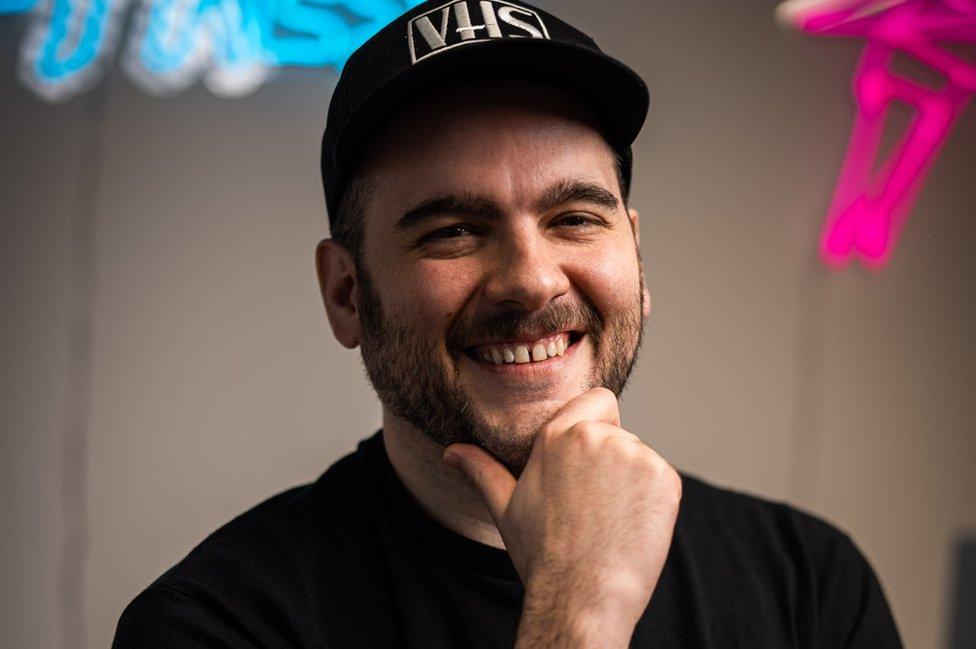
Matt Ferguson says his work has been met "overwhelmingly positively" by fans
Back in Sheffield, Ferguson, who uses a mix of traditional pen and pencil sketching as well as digital programmes, now also co-owns an artwork business called Vice Press.
He credits social media with having a "massive impact" on the way film marketing is done these days.
He explains it has helped studios tap into trends and get immediate feedback on releases, with Guardians of the Galaxy director James Gunn cited as a notable figure who regularly interacts with fans.
And he argues the re-emergence of "more dynamic artwork" over the last 15 years shows there is room for different approaches when studios make decisions over multimillion-pound films - which also creates opportunities for other illustrators to share his success.
"I think there's a place for a close-up of Tom Cruise on a poster because he's the star of Mission Impossible and people are going to go and see it because of him. A big star sells a movie.
"But there are two lanes now. Back in the day there'd be one key art poster, now there are multiple posters and space to do photos of famous people as well as artistic ones at the same time. It maximises their reach.
"People come up to me now at conventions and say 'you can do this as a job?' I'm like 'just try really hard, put your artwork out there and it can happen'."
- Published7 April 2023

- Published6 April 2023
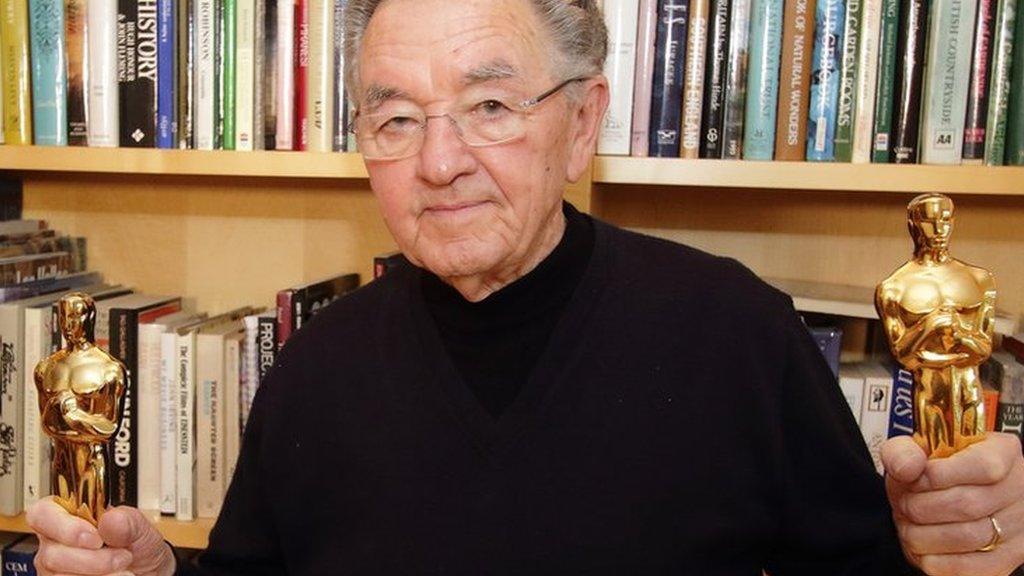
- Published24 September 2022
